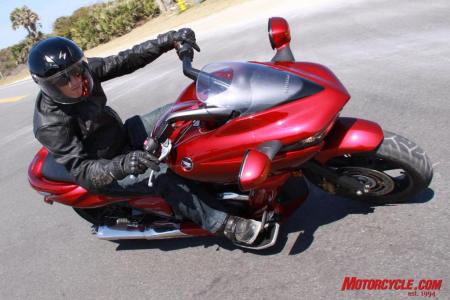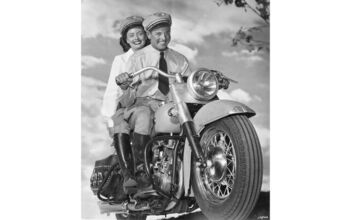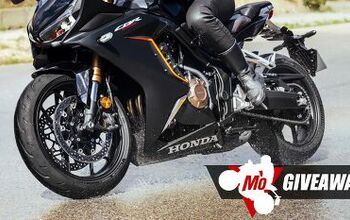2009 Honda DN-01 Review - Motorcycle.com
If the variety of motorcycles at Daytona’s Bike Week could be distilled into one machine, one could make a case that the Honda DN-01 would be the result.
V-Twin engine? Check
Feet-forward riding position? Check.
Attention-grabbing appearance? Check.
A dab of sportbike? Check.
The DN-01 is a peculiar concoction: two parts scooter; one part cruiser; and one part sportbike. And if you have to ride a scooterish motorcycle during Bike Week, this new Honda fits right in by standing apart, as we found out by cruising A1A and Main Street around Daytona last week.
Say what you will about purity, historical relevance, aesthetics or bling, riding during Bike Week is all about getting attention from fellow riders and bystanders. Trundling along down Main at a sub-walking pace on a Chevy V8-powered motorcycle makes no other sense. And in this respect, the DN holds its own in Daytona.
First seen in prototype form in late 2005 at the Tokyo Motor Show, the DN-01 (Dream New Concept 1) was described as a “comfortable sports cruiser.” Now having reached production, Honda calls the DN a “crossover.”
Whatever you call it, the DN-01 (could we please have a name with some personality…?) makes a splash wherever it’s ridden. Its arresting design hurt some necks in Daytona, as it caused hundreds of neck-snapping double-takes.
The DN defies immediate classification. Its shark-like nose brings to mind a futuristic sportbike and is its strongest styling asset, but its considerable length gives it a laid-back cruiser profile. It looks like a mega-scooter, too, but it’s lower than your typical touring scooter. A single-sided swingarm makes room for the stainless-steel exhaust and provides for easier access to the semi-adjustable rear shock
Riding the DN couldn’t be easier. It’s powered by a 680cc, 52-degree V-Twin borrowed from the European-market Transalp. Although it has roots to the late-1980s Hawk GT, the SOHC, 4-valve motor is thoroughly modernized with a sophisticated fuel-injection system using dual 40mm throttle bodies and high-tech 12-hole injectors.
In terms of Bike Week qualities, the DN’s deficiency is revealed after thumbing the starter button – this has got to be the most docile V-Twin exhaust note in history. The EFI’s auto-enrichment system ensures quick rideability. Then things get weird.
A rider subconsciously reaches for a clutch lever that isn’t there. This “crossover” is meant to appeal to less-experienced riders, so it is fitted with an automatic transmission. Called HFT (Human Friendly Transmission), this is a continuously variable, hydro-mechanical design that is a big leap in technology above the simple belt-drive CVTs (continuously variable transmission) in scooters. Honda says its HFT provides comparable performance and efficiency to a manual gearbox.
The HFT combines a hydraulic pump and motor that transmits power to the rear wheel by a conventional shaft drive, and the system seamlessly changes drive ratios in response to rider inputs. There are two fully automatic modes: D (Drive) is for maximum economy and for those in no hurry, while S (Sport) offers more immediate and snappy response. Maximum enjoyment is found by using the thumb-activated push-button manual mode that simulates a six-speed gearbox.
Although the HFT seems a bit gimmicky, it proves to be a highly refined transmission that can accommodate riders of all skill levels. The two automatic modes enable near-brainless operation, as the system feels similar to a CVT tranny. But the electronically controlled HFT automatically compensates for road inclines by a reducing the drive ratio, plus it has the ability to lock a ratio for optimum economy when cruising at constant speeds.
Other non-CVT bennies include a compression-braking effect when rolling off the throttle and the ability to switch it into neutral – perhaps the only scooter that allows you to rev the engine at stoplights. A one-touch, cable-actuated parking brake keeps the DN from rolling down inclines. In addition, the HFT’s compact design requires no scheduled maintenance.
Honda’s Automatic History- Soichiro Honda becomes interested in hydrostatic drives in the early 1950s.
- Honda licenses use of a patent for a machine-tool hydrostatic drive.
- Honda debuts the Juno in 1962, a Japanese-market scooter with hydraulic drive. A mechanically actuated system shifted gears via the left hand grip.
- The Honda RC250 factory motocross bike with an automatic transmission undergoes testing in the late 1980s.
- The Honda RC250MA motocrosser competed with the HFT in the 1990 all-Japan MX championship.
- The Honda Fourtrax Foreman Rubicon debuts in 2001 with a new-and-improved HFT.
- The 2008 DN-01 and its HFT are introduced in Europe.
After reaching for the non-existent clutch lever and get rolling, your next dilemma is to find the footrests. Once having fruitlessly searched for them somewhere below the cushy saddle, a rider eventually finds floorboards placed in a cruiser-esque forward position. While we appreciated the self-adjustable riding position available with the floorboards, their forward-placed location forces a rider’s butt to carry most of the body’s weight, so it becomes uncomfortable during long stints despite the seat’s generous padding.
Other than that ergonomic niggle, the DN has a comfortably open riding position with just a slight reach forward to the bars. A low 27.2-inch seat height ensures a stable platform even for shorties. A tidy but comprehensive LCD instrument panel includes a tach, clock and two tripmeters, plus a display for the trans mode and pseudo gear positions.
Although the DN-01 isn’t a small machine, said to weigh 595 lbs full of fluids and fuel, it is amazingly easy to handle for a bike with 63.2 inches between the wheels. The 41mm front fork is set at a relaxed 28.5-degree rake and has 4.5 inches of trail, but the bike doesn’t feel as cumbersome as the geometry might indicate. Credit its low stance and center of gravity, aided by a portion of its 4.0-gallon fuel capacity being located under the seat (linked to a primary tank in its typical placement in front of the rider).
Acceleration from the mid-size V-Twin engine is decent if not impressive. Sport mode is a good choice when you don’t want to think about shifting, but the DN is most fun when toggling through the manual mode. The DN even was able to out-drag an 883 Sportster from a stoplight, even if the Sporty’s rider didn’t make a super-aggressive launch. And 80-mph cruising isn’t a problem for the DN, although the protection from the small windshield is minimal.
Suspension quality is quite plush. The fork is non-adjustable and offers 4.2 inches of travel, while the single shock is preload-adjustable via a 7-position ramped collar and has a generous 4.7 inches of bump-sucking travel. Unlike most scooters, the DN has motorcycle-worthy rolling stock, with 17-inch aluminum wheels and big Z-rated rubber (130/70 front and 190/50 rear).
The DN-01’s technology theme continues in its brakes. It uses Honda’s Combined Braking System (CBS) plus an anti-lock system. Application of the front brake lever actuates five of six pistons in the dual three-piston front calipers using big 296mm floating front rotors (the same size as a Gold Wing’s!). The rear brake pedal engages a single piston in the left-side front caliper as well as the large 276mm rear disc.
These brakes will find favor with newbie riders. Instead of being tentative about how much traction is available from the front tire, a rider can mindlessly tramp solely on the brake pedal for quick, g-loading stops. The ABS eliminates lock-up, providing security even under dicey road conditions.
If the system has a fault, it’s that the brake pedal is mounted too high for my taste – a rider has to lift a foot up from the floorboard before application, which increases reaction time by a split second. An experienced rider will want to cover the front brake lever, as usual, for maximum power and to shrink reaction times.
The DN-01’s rider-friendly demeanor is evident when rolling around at low speeds such as down Daytona’s Main Street. The automatic clutch engagement is quite predictable but less so than a well-actuated clutch lever. The trick during ultra-low-speed maneuvers is to drag a brake to keep speed reined in. In parade mode, a moderate amount of heat from the right-side header reaches the rider despite extensive shielding.
Honda’s new sport-scoot-cruiser impresses in many ways, but it does have a few negatives. First, and nearly unforgivable for a scooter, is the DN’s complete lack of storage space. Despite the full-coverage bodywork, there is not a single bin in which to stow even a cell phone or keys. This is a significant shortcoming, especially considering Aprilia was able to make room for helmet storage in its automatic-trans motorcycle, the $9,899 Mana. And considering its abundant technology and intended audience, self-canceling turnsignals should be part of the deal.
Which brings up the DN’s largest obstacle to big sales numbers: At $14,599, this is one pricey scooter! This is Ducati territory, so it leaves out a large segment of prospective buyers. Honda has endowed the DN-01 with a multitude of expensive features like the HFT, CBS, ABS, a single-sided swingarm and swoopy sportbike-tinged bodywork, but this adds considerably to the net MSRP. From Honda’s perspective, they’re not anticipating huge sales for the DN, although the dealer reaction to the bike has been stronger than expected.
During our tour of Daytona Beach on the DN-01, I entered a conversation with perhaps the ideal customer for the scootercycle. We were parked in a Harley-Davidson demo ride area when a 40-ish couple stopped in their tracks to admire Honda’s handiwork. After educating them on the DN’s many features and its rider-friendly qualities, I pointed out that it would cost them nearly $15K for the pleasure.
They gave a response that Honda undoubtedly hopes to hear a lot. They didn’t seem to think the price was outrageous considering the DN’s state-of-the-art technology and its fantastic appearance.
More by Kevin Duke





































Comments
Join the conversation